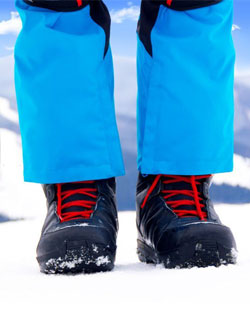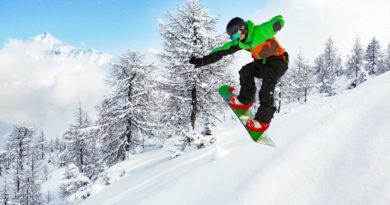How Should Snowboard Boots Fit?
A well-fitted pair of snowboard boots is critical to a successful day in the mountains. Your boots are the most crucial piece of gear; if you think about it, a poorly fitted pair of boots can easily ruin your day. Your boots should fit right, feel well, and your feet should stay comfortable. If your boots don’t fit well, you can’t ride comfortably no matter what board you choose. Always choose the size you usually wear because most companies are true to size these days. Sizing up and down doesn’t always work. So make sure when you are spending money, you are also getting the right fit and it is also a good idea to spend more on boots than bindings.
The Overall Fit

The first thing to see if your boots fit right is to put your foot in. Your toes should be touching the front of the liner. You don’t want it crammed up in there, instead, just touching. If you get the right size and your toes are touching the front, this does not mean the boot is too small. It just means that the boot is new and requires some break-in period. When you fully break your boots in, you also gain a half-size or even up to a full size depending on how hard you ride. Not only the inside of the boot is going to stretch but the outer shell is going to stretch as well.
One thing that is common in all snowboard boots is forward lean. When you are snowboarding, you need to be in a bent knee position. If you try to ride with your legs straight, you are going to have a lot of problems. Since you are going to be standing in that bent knee position most of the day, that’s why they build the boots with that forward lean. If they build the boot straight and you are bending all day, technically, you are forcing the boot into a position that you want to be in all day. Likewise, when you are trying your new boots at home, make sure you do it in that bent knee position for a better fit.
Know your Lacing System
Snowboard boots come with a lot of different types of lacing systems and if you don’t know how to use them, you may have a difficult time getting a comfortable fit. The lacing system plays a huge role in the overall fit of the boot. You can tighten or loosen the laces of your snowboard boots to get a more dialed-in fit. Snowboard boots come in three main types of lacing systems; traditional lacing system, speed lacing system, and boa lacing system. Every system has its advantages and disadvantages and choosing the one best suit your needs can be a preference thing.
Traditional Lacing System
This is the standard lacing system that you see in everyday shoes and boots. This lacing system has nothing new. You just lace them up, tie them up, and you are good to go. If the lace breaks, it is easy to find and replace. This lacing system is tried and tested and you will find it in most snowboarding boots. One of the good things about traditional laces is that you get three lacing zones, which allows you to fully customize how your boots fit.
Speed Lacing System
This lacing system is also known as Pull Strings Lacing. With this system, you get a pull tab that you can just loosen up, slide your foot in, and pull that string back to lock it up. What’s nice is that there’s just one thing to pull on and you are not fumbling with laces. The hard thing is that if the lace breaks, it’s hard to find a replacement lace. Different companies have their different versions of it but they all allow you to just pull up on one or two pull tabs to tighten or loosen your boots.
Boa Lacing System
The Boa Lacing System is just a cable connected to a dial that you can spin. As you spin that dial, the laces just get tighter and tighter until your desired tightness. Once you are done, you are ready to go. This is the fastest system of all and it is also very easy to use. Most boots come with a single dial but some advanced boots come with two dials to customize the top and the bottom. Boa system is also very durable and most companies give lifetime warranty.
So knowing the lacing system of your boots and utilizing it effectively will make a huge difference in the overall fit of the boot.
Try on Different Boots
If you have the luxury of being able to go into a store, try on a few different pairs of boots from different brands. Try on the different lacing systems, flex, and companies for your riding style and you could find a better fit. Also, try on boots from different price ranges and you can find a good pair in the budget category. Compare the fit, the comfort, and the flex according to your needs. You can also try on women’s versions and find a better fit as there are no differences besides colors and styling. If you order your boots online, try them on, crank them down nice and tight, and make sure it’s holding your heel down properly.
Frequently Asked Questions
There are some questions that many snowboarders often ask about boots:
How to stop heel lift?
A heel lift is a common problem in snowboarding boots and it is something you want to avoid on the hill. There are multiple ways to avoid this problem but one simple trick many snowboarders use is to alter boots to better hold your heel. Most snowboarders use J bars, which is a little foam pad that you can stick to the outside of the liner. It fills up extra space around your ankles so they don’t move. Most Burton boots come with built-in J bars and you can even adjust them according to your need. If your Burton boots didn’t come with built-in J bars, you can ask Burton and they will send you a pair of J bars.
How tight should snowboard boots be?
As mentioned earlier, your toes should just toes touch the end of the boot. This is the tightest the boot will ever be and you should not feel your toes crammed in the boots. At first, your boots may provide more than a close fit but boots get bigger over time as you use them. If your boots are too loose, you won’t have full control over your board and your feet and ankles will have to do extra work. Too tight boots, on the other hand, can restrict circulation in your feet and cause pain in your legs. Too tight boots can also make it difficult to turn at low speeds.
What if your snowboard boots are too big?
If your toes aren’t touching the front foot of the boot and you are experiencing a frequent heel lift, this means that your boots are a little too big and you need to size down. If you decide to wear a bigger boot, it will stretch out anyway and your foot will be moving around even more. Loosely fitted boots mean that you have a little control over your board and your feet and ankles are doing much more work. So always make sure your boots fit snugly without being too tight and you don’t feel any heel lift for a comfortable all-day ride.
How to know if snowboard boots are too small?
If your snowboard boots are too small, they will instantly feel uncomfortable. As mentioned earlier, if you feel that your toes are crammed in the front and the boot has more than a snug fit, your boots are a little too small for you and you need to size up. Boots that are too small can limit performance on the slopes. It also restricts circulation in the feet and you will have a difficult time making turns at low speed. Finally, you can’t wear thick socks with these boots. So these few things indicate that your boots are too small for you.




